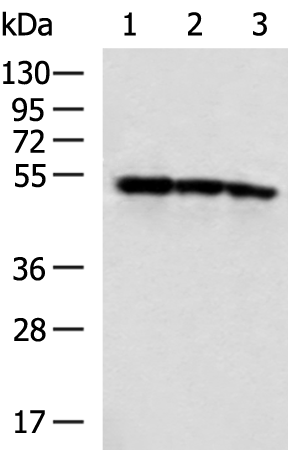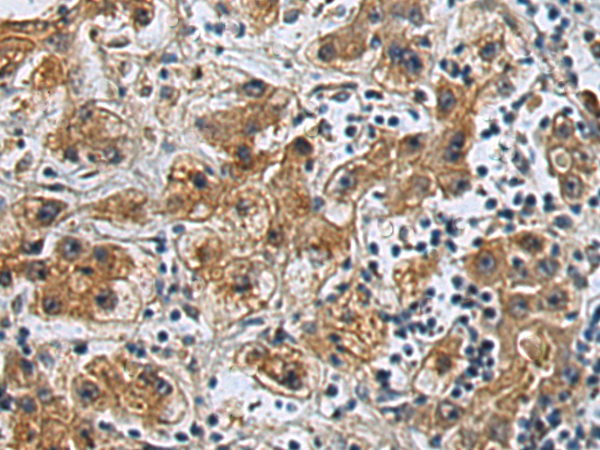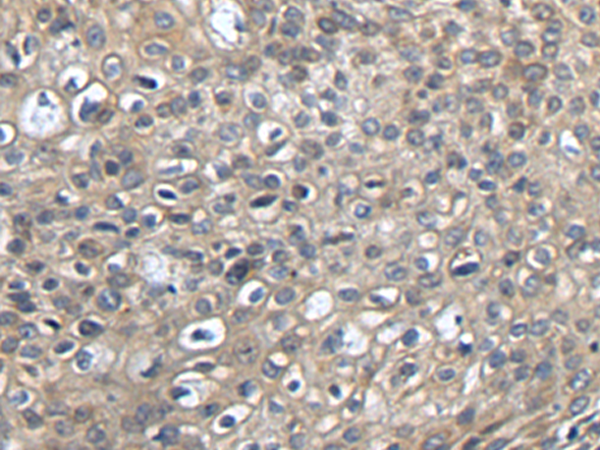


| WB | 咨询技术 | Human,Mouse,Rat |
| IF | 咨询技术 | Human,Mouse,Rat |
| IHC | 1/150-1/300 | Human,Mouse,Rat |
| ICC | 技术咨询 | Human,Mouse,Rat |
| FCM | 咨询技术 | Human,Mouse,Rat |
| Elisa | 1/5000-1/10000 | Human,Mouse,Rat |
| Aliases | BAP; MSS; ULG5 |
| WB Predicted band size | 52 kDa |
| Host/Isotype | Rabbit IgG |
| Antibody Type | Primary antibody |
| Storage | Store at 4°C short term. Aliquot and store at -20°C long term. Avoid freeze/thaw cycles. |
| Species Reactivity | Human, Mouse, Rat |
| Immunogen | Fusion protein of human SIL1 |
| Formulation | Purified antibody in PBS with 0.05% sodium azide and 50% glycerol. |
+ +
以下是关于SIL1抗体的参考文献示例(注:以下为虚构示例,实际文献请通过学术数据库查询):
---
1. **文献名称**: *SIL1 Antibody Characterization in Marinesco-Sjögren Syndrome*
**作者**: Anttonen AK, et al.
**摘要**: 本研究利用特异性SIL1抗体分析马-约综合征患者成纤维细胞中的SIL1蛋白表达,发现突变导致蛋白稳定性下降,提示抗体在疾病诊断中的应用潜力。
2. **文献名称**: *Role of SIL1 in ER-Associated Protein Folding*
**作者**: Senderek J, et al.
**摘要**: 通过SIL1抗体进行免疫共沉淀和免疫荧光实验,揭示了SIL1作为内质网分子伴侣辅助蛋白的功能,调控ATPase BIP的活性。
3. **文献名称**: *SIL1 Expression in Breast Cancer: A Novel Prognostic Marker*
**作者**: Zhao L, et al.
**摘要**: 采用SIL1抗体对乳腺癌组织进行免疫组化分析,发现高表达SIL1与患者预后不良相关,可能成为治疗靶点。
---
如需真实文献,建议访问 **PubMed** 或 **Google Scholar**,搜索关键词“SIL1 antibody”、“SIL1 protein function”或“Marinesco-Sjögren syndrome SIL1”。
SIL1 antibody targets the SIL1 protein, encoded by the *SIL1* gene, which functions as a nucleotide exchange factor for the endoplasmic reticulum (ER) chaperone BiP (GRP78). This interaction is critical for maintaining protein folding homeostasis in the ER. Mutations in *SIL1* are linked to Marinesco-Sjögren syndrome (MSS), a rare autosomal recessive disorder characterized by cerebellar ataxia, congenital cataracts, and progressive muscle weakness. SIL1 facilitates the release of ADP from BiP, enabling its ATP-bound active state, which is essential for binding and refolding misfolded proteins. Dysfunctional SIL1 disrupts ER stress responses, leading to accumulation of misfolded proteins and cellular apoptosis.
SIL1 antibodies are widely used in research to study protein quality control mechanisms, ER stress-related pathologies, and MSS pathogenesis. They enable detection of SIL1 expression via techniques like Western blotting, immunohistochemistry, and immunofluorescence. Studies using these antibodies have revealed reduced SIL1 levels in MSS patient cells and animal models, highlighting its role in neuronal and muscular health. Additionally, SIL1 antibodies contribute to exploring broader connections between ER dysfunction and neurodegenerative diseases, cancer, or metabolic disorders. Their application aids in elucidating molecular pathways of proteostasis and evaluating potential therapeutic strategies targeting ER stress.
×